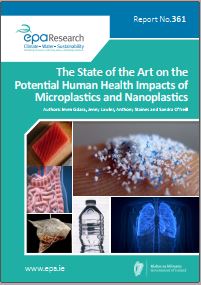Research 361: The State of the Art on the Potential Human Health Impacts of Microplastics and Nanoplastics
Authors: Imen Gdara, Jenny Lawler, Anthony Staines and Sandra O’Neill
Summary: Human exposure to microplastics and nanoplastics through inhalation, ingestion and dermal exposure is an emerging health concern. Designing studies to assess the health effects of these exposures is challenging. Until these studies are conducted, governments should revise directives and policies on food, water and air to include MPs/NPs, to remove the potential for plastic to contaminate the food chain and our environment.

Identifying Pressures
Plastic pollution is a global environmental problem. Human exposure to microplastics and nanoplastics (MPs/NPs) through inhalation, ingestion and dermal exposure is an emerging health concern. While it is possible to investigate the levels of exposure through food, air and water, it is not yet possible to estimate individuals’ daily exposure levels, as exposure through all three routes has not been comprehensively investigated. Dietary exposure through seafood and water is the most extensively studied, and the data have given rise to food safety concerns. However, the lack of evidence around the effects of MPs/NPs in human populations means that we cannot fully assess the risk. Laboratory studies show that MPs/NPs affect cell function and could lead to a number of detrimental human health effects. There are many state-of-the-art techniques to measure the presence of MPs/NPs in the environment, but to date there are no standardised and validated international protocols to reliably measure MPs/NPs in different sources. Thus, studies investigating MPs/NPs in humans are lacking, simply owing to the lack of direct methods that demonstrate their retention in tissues in situ.
Informing Policy
It is critical that policies and recommendations are established to address the major challenges associated with MPs/NPs. The Irish Government effected a 90% reduction in plastic bag use by the introduction of plastic bag levies in 2002, and has since banned microbeads in cosmetic products and detergents. In 2021, Ireland plans to enforce a levy to reduce single-use cups, and in the future will ban plastic plates, cutlery, straws, balloon sticks, cotton buds and food containers. Given that water, food and air are the main sources of human exposure to MPs/NPs, it is vital that all relevant EU directives and national policies and guidelines are amended to explicitly include MPs/NPs. Ireland, as a Member State, must take specific measures to identify the main sources of MPs/NPs in the environment, specifically those that pose the greatest threat to human health. Once identified, the development of policies and practices to measure levels of exposure in our environment is critical to reduce the potential negative impact on human health.
Developing Solutions
The ubiquitous exposure of humans to MPs/NPs through inhalation, ingestion and dermal exposure makes designing studies to assess health effects challenging. While the routes of human exposure are clearly defined, there is a requirement for standardised fast-throughput methods and validated international protocols to enable measurement of exposure from different sources over time. There is a need to develop specific methods to measure MPs/NPs in human tissue and to identify populations with high-level exposure to facilitate investigations of the impact of MPs/NPs on human health. While laboratory studies link MPs/NPs to cancer and inflammatory, endocrine and reproductive disorders, there is a need for studies to link these effects to MP/NP size and composition and the chemical transfer of adsorbed chemical pollutants, so that any potential toxic substances can be banned for use in plastics. Until these studies are conducted, governments should revise directives and policies on food, water and air to include MPs/NPs, and every effort should be made to remove the potential for plastic to contaminate the food chain and our environment.
https://www.epa.ie/media/epa-2020/publications/research/Thumbnail_361.jpg